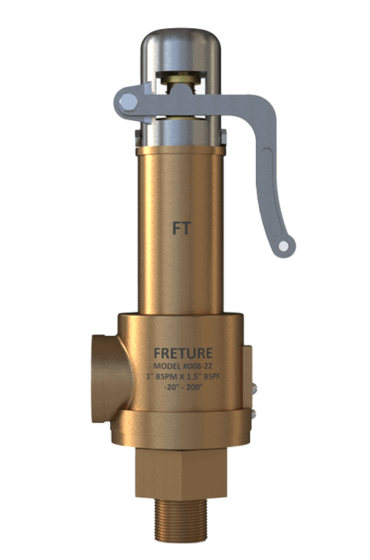It is a mechanical device designed to automatically release pressure from a system when it exceeds a predetermined limit to prevent equipment failure or explosion.
Safety Valve Series #088
FRETURE safety valve conforms industry standards, including ASME SEC VI 1, ASME SEC VI 1 & ASME 16.34, API 526 & 520, API 527, IS 12992, and EN ISO 4126 Part 1. Available in sizes ranging from 15NB - 200NB it offers versatile end connections with thread and flanged options.set pressure range spans from 1 BAR to 255 Bar, and temperature range of -196°C to 300°C. features direct spring operation, full lift, full nozzle, single trim, adjustable blow-down ring, small orifice, high-pressure design, and superior seat tightness. Ideal for air, gas, steam, and liquid applications.

Description | Features |
|---|---|
TYPE: Safety Valve Flanged End Connection: Thread & Flange End Connection (BSP, BSPT, NPT, etc.) Size: 15NB - 200NB Pressure Rage: 0.5 to 255 Barg Temperature Range: -196°C to 400°C Body Materials: Stainless Steel, Carbon Steel, Brass, etc. Design Standard: Direct Spring Operated, Full Nozzle & Single Trim Design Seat Options: Metal Seat or Soft Seat Operation: Direct Spring Operated Certification: CE Certified under Category IV Module H (2014/68/EU) |
|
FAQ’s
Have a question before you buy our products? Take a look at the FAQs below.
If you don’t find the answer you’re looking for, get in touch with us here.
- What is a safety valve?
- Why are safety valves important?
why they are crucial for preventing overpressure conditions, which can lead to catastrophic equipment failure, fires, or explosions in industrial systems.
- How does a safety valve work?
A safety valve opens when the pressure in a system exceeds the set pressure, allowing excess pressure to be released until the system returns to a safe level.
- What are the common applications of safety valves?
Safety valves are used in various applications, including boilers, pressure vessels, pipelines, chemical processing plants, and other industrial systems requiring overpressure protection.
- What is the difference between a safety valve and a relief valve?
Safety valves typically release pressure rapidly and fully to prevent catastrophic failure, while relief valves usually operate more gradually to control overpressure.
- What is backpressure, and how does it affect safety valves?
Backpressure is the pressure that exists at the outlet of the valve. It can affect the valve’s performance, so balanced or pilot-operated safety valves may be required in systems with significant backpressure.
- What maintenance is required?
Regular inspection, testing, and cleaning are necessary to ensure the proper operation of safety valves. Periodic testing and recalibration should be conducted according to the manufacturer's guidelines or industry standards.
- Can they be repaired?
Yes, safety valves can often be repaired or recalibrated by qualified technicians. However, if the valve is extensively damaged or beyond repair, it may need to be replaced
- How do you select the right safety valve for an application?
Selection depends on factors like set pressure, temperature, flow rate, fluid type, and compliance with relevant standards and regulations.
- Why is Freture the best place to buy from?
Freture is the best place to buy safety valves because it offers a wide range of high-quality products, expert advice on selecting the right valve for your application, excellent customer service, and competitive pricing. Additionally, Freture ensures all products comply with industry standards, providing peace of mind and reliability.
Industries where Safety Valve is used
Chemical Processing
Oil and Gas Industry
Food And Beverage Industry
Power Generation
Pharmaceutical Industry
Oil and Gas: Used in drilling rigs, pipelines, and refineries to prevent overpressure situations that could lead to explosions or equipment failure
Manage Pressure: In HVAC systems, It utilized in refrigeration systems, boilers, and air compressors to manage pressure and ensure safe operation.
Prevent Contamination Safely: Used in bioreactors, fermenters, and other pressure systems to ensure safe operation and prevent contamination.
Power Generation: Utilized in boilers, steam turbines, and heat exchangers to maintain safe pressure levels and prevent catastrophic failures.
Prevent Overpressure: Installed on ships in various systems such as propulsion, heating, and cargo handling to prevent overpressure and ensure safety at sea.





